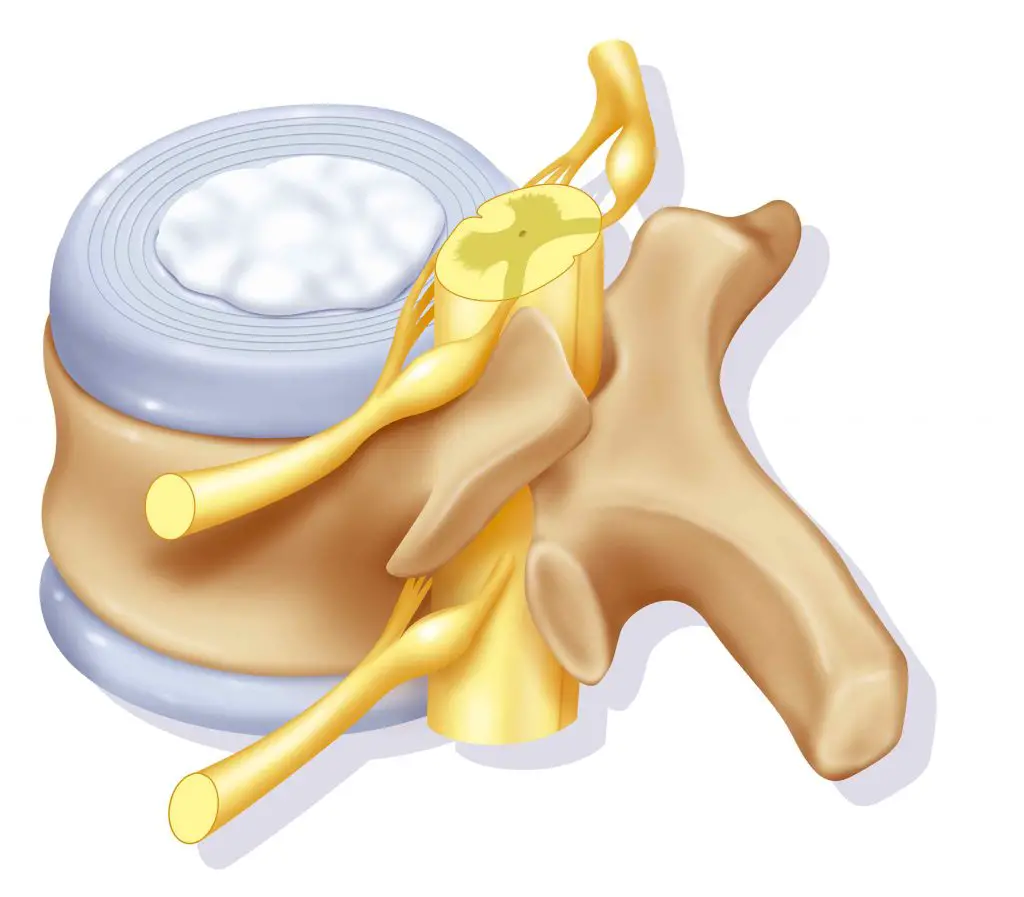Article reviewed and approved by Dr. Ibtissama Boukas, physician specializing in family medicine
If you are viewing this page, you would like to know more about the anatomy of the intervertebral disc. You may have a disc disease such as herniated disc, disc protrusion or degenerative disc disease. Or, you would like to know more about discs and their relationship with the spine.
This article covers everything you need to know about the intervertebral disc (anatomy, definition, associated pathologies, healing, etc.).
Intervertebral Disc Definition and Anatomy
A short anatomy lesson will help to better understand the definition of an intervertebral disc. Let's start by identifying the main structures that are part of the spine:
The spine (or vertebral column) is made up of vertebrae superimposed. The cervical region (the neck) includes 7 vertebrae numbered between C1 and C7. There dorsal region (or thoracic), for its part, comprises 12 vertebrae numbered between T1 and T12 (or even D1 to D12 according to nomenclatures). Then the lumbar region (the lower back) has 5 vertebrae numbered between L1 and L5. Finally, the sacral region (composed of the sacrum) has 5 welded vertebrae (although numbered between S1 and S5)
Between each vertebra, there is a intervertebral disc. For example, we call disc C4-C5 the disc which is located between the cervical vertebrae C4 and C5. At neck level. Or, the T-T12 disc is between the T11 and T12 thoracic vertebrae. Last example: the L5-S1 intervertebral disc is located between the last lumbar vertebra (L5) and the first sacral vertebra (S1).
In summary, the intervertebral discs are structures located between 2 superimposed vertebrae. When we study the composition of these discs, we see that they look like pads. More specifically, they are composed of a gelatinous nucleus (Nucleus pulposus) in the central region, surrounded by a fibrous ring (Annulus fibrosus).
But what are the intervertebral discs for? Their roles include:
Role of the intervertebral discs:
- The separation of the vertebrae from the spine
- Shock absorption during movements involving impact (walking, running, jumping, etc.)
- The distribution of pressures thanks to the gelatinous core
- Mobility between the vertebrae
What you have to remember is that the gelatinous nucleus can move inside the disc. This displacement can sometimes be the cause of disc pathologies.
Pathologies related to the intervertebral disc
disc protrusion
A disc protrusion refers to a protrusion of the disc due to pressure from the gelatinous nucleus on the annulus fibrosis.
To learn all about disc protrusion, see next article.
Herniated disc
In the case of a herniated disc, the gelatinous nucleus pierces the fibers of the annulus that surrounds it, which creates a slippage of the disc towards the spinal canal. Depending on the degree of damage, disc herniation can be classified into several types:
Bulge:
This is another name to qualify the disc protrusion. As a reminder, the disc is deformed, but the gelatinous nucleus has not yet pierced the fibrous ring. Note that a protrusion can sometimes evolve into a herniated disc, if the pressure exerted by the gelatinous core is significant enough and pierces the fibrous ring.
extrusion:
In this case, the hernia has pierced the annulus fibrosis, but the protruding section of the gelatinous nucleus remains in contact with the rest of the gelatinous nucleus present in the intervertebral disc.
Sequestration:
Here, the breakage is so great that the protruding part of the nucleus is no longer in contact with the rest of the intervertebral disc.
Degenerative disc disease
In the presence of degenerative disc disease, progressive damage to the intervertebral discs is observed. These can be the site of micro tearing, dehydration, deformation or cracking. The most common cause of degeneration is osteoarthritis, and thus leads to progressive wear of the discs.
To learn more about herniated discs, see next article or get the full guide here.
Intra spongy hernia
On the other hand, in the case of intra spongy hernia, the sliding of the gelatinous nucleus does not occur laterally as in typical disc herniation. Rather, the nucleus migrates downward (or sometimes upward) toward the adjacent vertebra. It then penetrates the vertebral body of this vertebra.
To know everything about intra spongy hernia, see the following article.
Regenerate a worn or damaged intervertebral disc?
As mentioned, the discs degenerate over the years. In other words, they lose their ability to perform their roles well. It is the beginning of a process of degradation of the vertebra and the intervertebral disc. Moreover, a sedentary lifestyle seems to accelerate this process of degeneration.
Conversely, it seems that physical activity would improve the condition of your discs. Some studies have shown that activities involving dynamic movement at slow to moderate speeds and including axial compression (up and down, in line with the spine) promote disc regeneration (Belavý & coll.).
Thus, discs seem to have a positive adaptation to physical exercise. Now, it is important to stay active in a safe and progressive way, otherwise the condition of your discs could worsen and cause lumbago and back problems.
To learn how to train with back pain for therapeutic benefits, check out next article.

